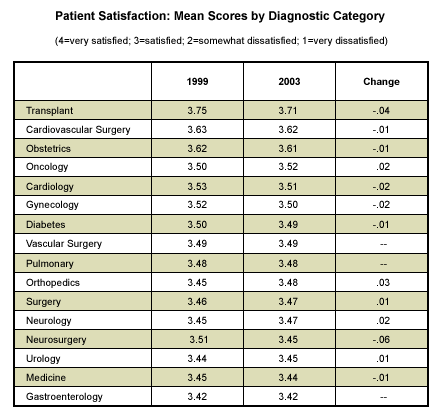Hospital administrators often wrestle with the question of whether patients who are in the hospital for different reasons tend to perceive the quality of hospital services differently. Research conducted in 2002 (on healthcare data collected in 1999 and 2001) found that differences in satisfaction by diagnostic category are relatively minor, which suggests that focusing on them could pose a barrier to overall quality improvement (see "The Diagnoses for Patient Satisfaction" in Related Items). Two years later, does this hypothesis still hold true?
Satisfaction by Patient Type
Many hospitals attempt to compare patient satisfaction scores by general treatment type (medical, surgical, pediatric, etc.). But these comparisons may be unreliable when high occupancy levels force hospitals to assign patients to beds irrespective of medical diagnosis or unit designation. In those circumstances, specialty units meant for one type of patient often actually include patients with different conditions.
When examining patient satisfaction, it may be more helpful to group patients by diagnostic-related groups (DRGs) -- a classification system based on patients' actual conditions or diagnostic category (oncology, orthopedics, neurology, etc.), regardless of which unit of the hospital they're located in. In that light, satisfaction ratings from 1999 were compared with patient responses from 2003 to determine whether any major changes occurred by diagnostic category.
A Patient Is a Patient
The 2003 mean scores for patient satisfaction by diagnostic category remain similar to the 1999 mean scores. Scores are relatively stable both within and across categories.

For both years, the same three categories -- transplant, cardiovascular surgery, and obstetrics -- form a cluster at the top, with mean patient satisfaction scores of 3.71, 3.62, and 3.61, respectively (these are average ratings based on a scale of 1 to 4). For at least two of the three categories -- transplant and cardiovascular surgery -- the high scores could be a result of the highly structured nature of the care teams, which makes it easier for them to coordinate and implement responses to patient satisfaction data, and the low patient-to-employee ratios.
Looking at the remaining 13 categories, there appears to be a significant variation between 4th-ranked oncology (3.52) and 16th-ranked gastroenterology (3.42). However, looking down the list, the scores for all of the categories are spread evenly through that range, with no obvious outliers.
Eight of the diagnostic categories experienced a decline in patient satisfaction scores between 1999 and 2003, while five categories experienced increases and three remained the same. Only three categories showed substantial change:
- Neurosurgery (-.06)
- Transplant (-.04)
- Orthopedics (+.03)
The improvement in scores for orthopedics may plausibly reflect a tendency toward improved coordination there. As inpatient orthopedic surgery departments become more focused on joint replacement in many facilities, it is possible that the increased specialization of orthopedic teams has led to better communication and higher patient satisfaction.
The decline in scores for neurosurgery and transplant is more troubling. To be treated for these specialized conditions, patients are in many cases no longer limited to "centers of excellence" -- i.e., facilities renowned for a particular specialty, where greater experience denotes a higher level of patient care. As insurance plans direct patients to less expensive alternatives, might the reduced volume be eroding patients' perceptions of expertise at these centers of excellence? Or do the declines result more from shortages of highly skilled, specialized patient care staff? These data can't answer such questions conclusively, but the declines in these categories are definitely a concern.
Bottom Line
Recent data reinforce the finding that life-saving transplant and cardiovascular surgery departments have an advantage when it comes to patient satisfaction scores. But does that advantage stem from the patient's diagnosis or from the nature of the patient care team? Gallup research continues to indicate that the only truly consistent key to quality improvement is the employee workgroup, not the patient's particular diagnosis. Engaged employees with appropriate skill and talent mixes and adequate availability are ultimately what drive gains in patient satisfaction.